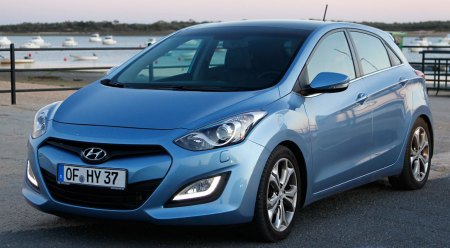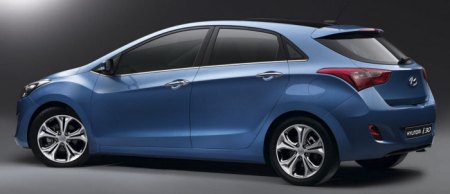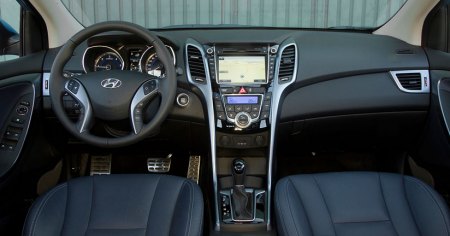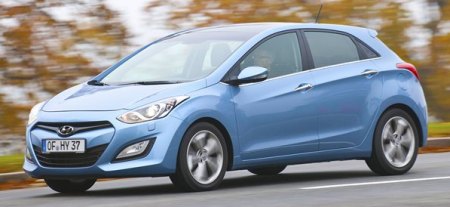Published
on 22
Mar 2012
|
All rights reserved.
|
|
|

Opposing
to the industrial trend of globalization, Hyundai produces the i-series
models specially for European market. i10, i20, i30 and i40 are
tailored to the needs and tastes of European motorists, which can never
be fulfilled by the American-biased Accent, Elantra and Sonata. This
shows the company's determination to succeed in Europe. It goes without
saying that winning the hearts of European motorists is the hardest
thing yet the highest honor one can achieve.
The first generation i30 debuted in 2007 as the badge-engineered sister
of Kia Cee'd. Both cars caught us a small surprise by offering
competitive packaging and dynamics, but no one would confuse them with
the best European family hatches, namely Volkswagen Golf, Ford Focus
and Opel Astra. Now the second generation i30 is going to close the gap
again.
In certain areas, the new i30 could really threaten its established
rivals. Most notable is the exterior design, which was penned by
Hyundai's European HQ at Russelsheim, Germany. It looks sporty,
tasteful yet original – I know the last adjective is rarely associated
with Asian brands, but you had better to get used to it for nowadays'
Hyundai and Kia, because they take design very seriously. Take the
hexagonal fascia for example, it is radical yet very well integrated
with the nose, something not even Audi A3 or Alfa Romeo Giulietta
managed. It makes VW Golf conservative and Ford Focus odd. The side
view
shows a similar story. Sharp, flowing crease lines reveal an unusually
dynamic graphic, which is best described by Hyundai's own language -
Fluidic Sculpture.

Apart from styling, the i30 was also engineered at Russelsheim. Its
production takes place at the Nosovice plant of Czech Republic, just
like the old car. No wonder it smells and drives exactly like a
European car. Although its basic platform is shared with Elantra and
Veloster, it is fitted with expensive multi-link rear suspensions
instead of the usual torsion-beam axle in order to deliver a more
sophisticated ride and body control that many European motorists
demand. This lets it to stand proudly beside Golf, Focus and Giulietta
and have a psychological advantage over Astra, Megane, 308 etc. Up
front, the usual MacPherson struts are mounted on subframe to isolate
from NVH. Further noise insulation is provided by double-layer door
seals and increased foam-filling in the A-pillars. As expected, the
monocoque chassis employs more high-strength and ultra-high-strength to
increase rigidity. A reduction of drag coefficient by 10 percent to
0.30 helps cutting wind noise as well as highway fuel consumption.
The packaging is also improved. Although wheelbase is unchanged at 2650
mm – that's 50 mm shorter than Elantra – front occupants enjoy 30 mm
more headroom, 11 mm more legroom and 5 mm more shoulder room compare
with the old car. Space at the back is mostly unchanged, but a lower
central tunnel eases the pain of the middle passenger. Cargo space is
increased from 340 to 378 liters, which is bigger than both Golf and
Focus.

In the cabin, the roominess you sense is even more than the tape
measure suggested, because the base of the windscreen is set further
away, freeing up more space in front of you. The build quality and
materials used throughout the cabin is certainly better than Elantra,
again to please European buyers. Soft-touch plastics are used on the
dashboard and door panels. Gloss and metallic inserts look good enough.
Overall, it fails to match the quality feel of Volkswagen, but it won't
be shame to compare with any other European rivals. Ergonomics are
excellent. Buttons are large and logically placed. The only complaint
is the rear seats that don't fold entirely flat.
As usual, the Hyundai is better equipped than rivals of the same
prices. In addition to its unique 5-year warranty, value for money is
unrivalled.
So the new Hyundai is very strong at packaging, styling and value, but
what about its driving dynamics? Look at the specification sheet, you
will find some very promising mechanicals. For example, the electric
power steering offers 3 modes – Comfort, Normal and Sport – to change
the level of assistance according to your will. The 1.6 GDI engine uses
direct injection and dual variable valve timing to produce a remarkable
135 hp. Equipped with an automatic stop-start system called ISG, it
claims an eye-popping economy of 56.4 mpg and carbon-dioxide emission
of only 118 g/km, which is the best in 1.6-liter class. Even more
impressive is the 1.6CRDi turbo diesel engine, which quotes 128 hp, 192
lbft, 76.3 mpg and 97g/km. Both engines can mate to either 6-speed
manual or 6-speed automatic transmission. Everything looks good on
paper.

In the real world, things do not turn out as good. Both engines fall
short of their rated fuel economy by a large margin (by the way, the
same happens in the American Elantra). The 1.6 GDI offers plenty of
power if you are willing to stretch its rev, but doing so will
undoubtedly hurt its frugality. For day-to-day use it is not as
flexible and frugal as the small turbocharged motors on Golf 1.4TSI and
Focus 1.0 Ecoboost. The 1.6 CRDi has similar problems. While it is
quiet and rattle free, its power band is narrow. This mean it does not
feel as strong as its output figures suggested.
The chassis is competent. Its primary achievement is to deliver a
comfortable ride without compromising body control. Most buyers will
love its new found rolling refinement, safe and predictable handling.
Compare to the old car, it feels more grown up to the extent that you
can easily confuse it with some of the best European rivals.
Nevertheless, the car is not fun to drive. Its comfort-biased
suspension setting fails to translate into a handling as sharp as Focus
or Golf. Its power steering feels artificial regardless of modes,
something its best rivals managed to avoid. Consequently, the driving
experience is rather dull.
Undoubtedly, the new i30 has improved a lot from its predecessor.
Buyers will be foolish to ignore it when purchasing a new C-segment
family car, especially taking financial factors into account. However,
it still needs to inject more driving fun, character and innovation
before it can be get our recognition as the best of the class.
|
Verdict:     |
|